7 Software Development Models You Need To Know – BiPlus
A software development model or software development process is a set of organizational phases, stages, or activities that is used to build and develop software. Different software development models will provide you different ways to achieve your goals for software projects. The clear directions and methods of these processes could bring high quality, productivity and also increase competitiveness and profits to your enterprises. There are many types of software development models. Have you got it all yet? Let’s check!
What is software development models?
Software development models are the various processes or methodologies that are being selected for the development of the project depending on the project’s aims and goals. Various development life cycle models have been created in order to meet various necessary goals. The steps of the process are laid out in the models, along with their sequence of execution.
The testing that is done is significantly impacted by the model choice. It will specify the what, where, and when of our anticipated testing, have an impact on regression testing, and greatly affect the test methodologies to be employed. It’s crucial to pick the best model while creating a software program or application. The development and testing activities are carried out based on the model. Different businesses with various software programs or products will select one that works effectively for them. Review the following list of 7 software development models to determine which is ideal for your business.
1. Waterfall Model
The waterfall model is one of the easiest software project management models to understand today. It is a project management methodology based on sequential design.
In the waterfall software development, the phases of the project are executed in turn, the new phase is only started when the phase before it has been completed. The waterfall method was created to be a software development life cycle model but is also applicable in projects that are small and clearly defined from the start.
Advantages:
- Suitable for simple or small projects
- The project team clearly understands the requirements
- Easy to understand
- Easy to manage
- No need to set milestones for implementation
- There are many documents providing information for customers
Defects:
- Do not allow to change project scope
- Do not allow to change the requirements of the project
- No working product until the project is almost complete
- It is not easy to handle unexpected risks
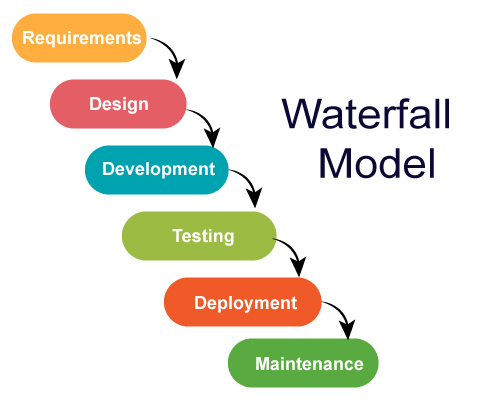
2. Agile Model
Agile is one of the most flexible software development models in software engineering field, which has a specific approach. It includes an integrated and interactive workflow to get the product into the hands of users as quickly as possible.
Agile development model works with the following principles:
- Personal and interaction rather than process and tools
- Better running software than full documentation
- Collaborate with customers rather than negotiate contracts
- Respond to change rather than stick to a plan
Advantages:
- Agile is a great choice of
software development models types
for small projects because these projects often have poorly defined requirements and can change often.
- With Agile customers can preview each part of the project throughout the development process. From there, you can follow the project and always be ready for any changes required by the customer on the project.
- Agile divides the project into small parts and assigns each person
- The success rate of projects using Agile is often higher than other processes.
Disadvantages:
- Lack of emphasis on design and necessary documentation
- Human resource is usually limited from 7 to 10 people, there will be a big obstacle if the human resource requirement exceeds this number for example in exchange meetings.
- The number of requirements can be large and difficult to manage if it covers many different aspects of the project.
- As the number of human resources increases, the quality becomes more difficult to control.
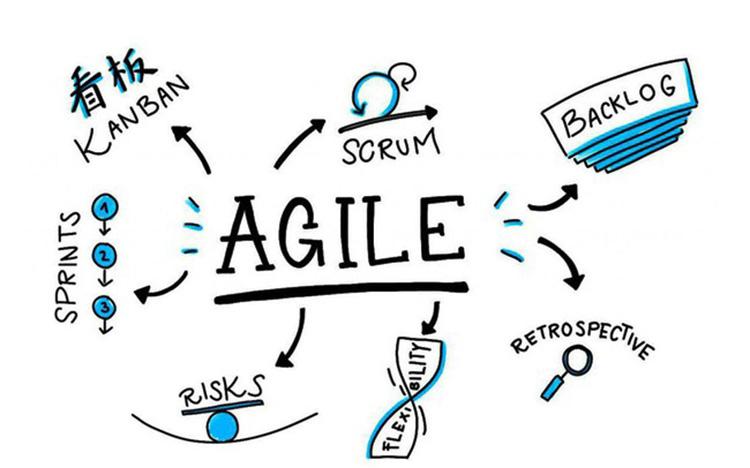
Scrum
Scrum is a management framework related to the Agile models of software engineering that helps solve complex problems, but still ensures the efficiency, the creativity of products in the software development processes. Scrum itself is a simple but the most effective coordination among development team members when implementing products. With Scrum, the product will be built on a sequence of iterative processes (called a Sprint). Sprints take place regularly, each sprint is an opportunity to learn and adjust to achieve the best results.
Advantages of the Scrum:
- Scrum can help teams complete project delivery quickly and efficiently.
- Scrum ensures efficient use of time and money
- Large projects are broken down into manageable sprints
- Developments are coded and tested during the sprint review
- Teams get a clear vision through Scrum meetings
Disadvantages of the Scrum:
- Scrum often leads to a change in scope, due to the lack of a defined end date
- The probability of project failure is high if individuals are not committed or cooperative
- Adopting the Scrum framework in large teams is challenging
- The framework can only succeed with experienced team members
- Daily meetings sometimes frustrate team members
- The quality is hard to ensure if the team goes through an aggressive vetting process
Kanban
Kanban (meaning signboard in Japanese) is a lean method for managing and improving work across the human system. It is a small branch of Agile – a popular model of software engineering, which sets aims to manage work by balancing needs with existing capacity and improving the handling of bottlenecks at the system level. Work items are visually displayed to give participants a view of progress and process, from start to finish — often via a Kanban board. Work is pulled by enablement, rather than pushing work into the process when required.
Advantages:
- Time accuracy.
- Maximum saving of supplies and materials.
- Product life cycle rotates fast and the ability to disperse labor is high.
- Shows a big problem to be solved by the workshop.
- Helps to understand the situation, arising based on the flow of information between workplaces.
- Close coordination between workplaces.
- Adapt the production process according to demand, the minimum amount of inventory, and no need for a daily plan.
Disadvantages:
- Applying the Kanban system, the factory will have little or no inventory, so with large fluctuating requirements, it will not be able to meet.
- Disruption at one stage will affect the whole system.
3. RAD Model
RAD modeling is one of software development models types that uses minimal planning in favor of rapid prototyping. Functional modules are developed in parallel as prototypes and integrated to create the finished product for faster product delivery. Rapid Application Development Model ensures that the developed prototypes are reusable.
Advantages:
- Reduces development time.
- Increases reusability of components.
- Makes a quick initial assessment.
- Encourages customers to give feedback.
Defect:
- The level of the developers requires a certain skill.
- Only systems with modules can use this model.
4. V-Model
The V-model is one of the striking types of software development models, which is an extension of the waterfall model and is based on a combination of a test phase for each respective development stage. This is a highly disciplined pattern and the next phase only begins after the completion of the previous one. With the V-model in software engineering, the testing work is involved from the beginning.
Advantages:
- This is a highly disciplined pattern and the stages are completed at the same time.
- Works well for small projects, when the requirements are very well understood.
- Simple and easy to understand and easy to use, easy to manage.
Defects:
- Difficult to manage risk control, high risk.
- Not a good pattern for complex and object-oriented projects.
- Poor model for long and ongoing projects.
- Not suitable for projects with medium to high risk of change requirements.
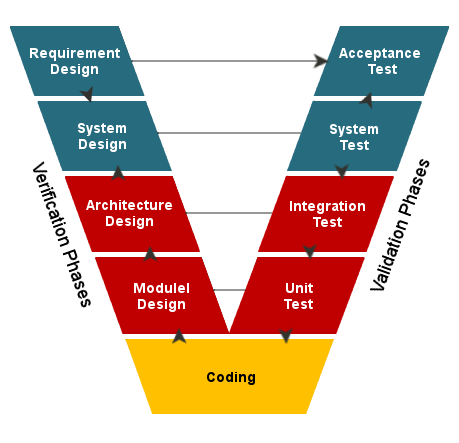
5. Prototype Model
Prototype is considered as a great model in software development models list which based on system requirements. Using prototype model, the customer has an overview of the actual system. Prototypes are a good idea for large and complex systems that don’t have a manual process to help define requirements. The goal is to provide a system with overall functionality.
Advantages:
- Bugs can be detected early and fixed sooner
- Users will easily notice inadequacies and offer solutions to solve them sooner
- Avoid system failure
- Complicated functions are identified and explained earlier
- Authentication is required by the system thereby making the application faster but not fully functional
Defects:
- The prototype can increase the complexity of the system because the scope of the system can be extended beyond the original plans.
- This prototype is evaluated by the customer himself, if the prototype is not satisfied by the customer, it must be redone, wasting time and effort.
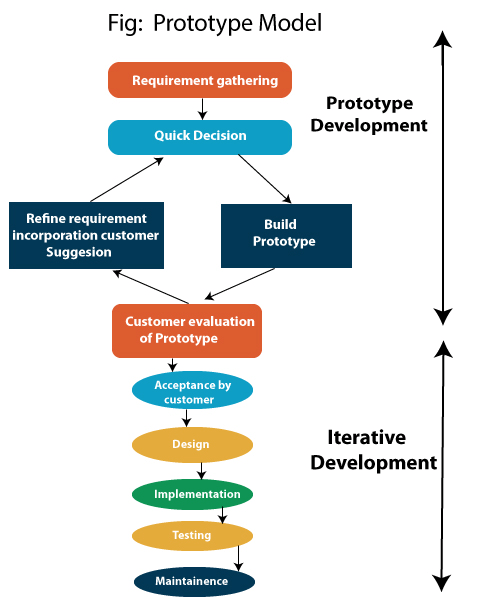
Incremental Model
Incremental Process Model In Software Engineering breaks software processes into different versions, from a large cycle into many small cycles corresponding to each version, and thus we get a multi-cycle development. Each small cycle corresponds to a division called a module which is simpler and easier to manage, each module is also built in steps such as analysis, reading project requirements, writing design, and coding. The principle of this model is the same as making a picture from puzzle pieces, the first piece completed will give us a part of the picture shown first, and over time, the number of completed pieces will increase and the product is getting more and more perfect.
Advantages:
- It is possible to prototype a product early in its development lifecycle.
- Greater flexibility and when changing project requirements, the cost will be less because that module will change without other modules being affected.
- The division into modules will also make the test lighter, the simple modules, the test is also simple, soon finished.
- Reduce costs for the first-time delivery of products.
- Easily manage risks that may arise.
Defect:
- It is necessary to have good design skills and good methods, to be able to understand the requirements well and know how to divide them properly.
- The cost to develop this method is very high, much higher than the waterfall.
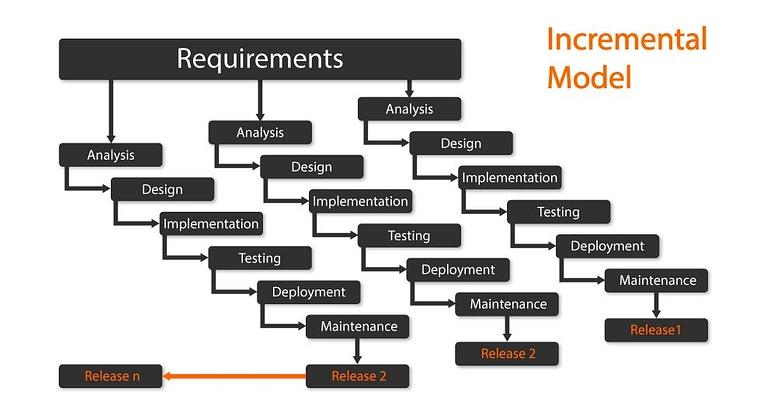
XP
Extreme Programming (abbreviated as XP) is one of the Agile-based software development models, used to improve software quality and increase adaptability to changing requirements. It has proven to be very effective in many companies from small to large, in diverse industries around the globe. It also allows developers to confidently make required changes, even in the late stages.
Advantages of XP in software engineering:
- XP improves teamwork
- Builds real capacity in all members of the team
- Makes work interesting.
- TDD (Test-driven development) guides developers
- Develop to write quality code and how to improve
- Design concept; help improves estimation.
- Provides many tools for management, including the ability to predict
- Predictability, flexibility of resources, consistency, and visibility
- Gives customers the ability to review whether the company can tackle tasks or not
- Don’t waste time and don’t create a lot of unnecessary documents
Disadvantages of XP:
- Design becomes implicit instead of obvious
- Relying on design is risky
- It is very difficult to write good tests
- Repeating too often can degrade the quality
- To perform well, it must be done regularly
6. Spiral Model
It is a popular model in the software development models list that combines features of the prototyping model and the waterfall model. The spiral model in software engineering is preferred for large, expensive, and complex projects. This model uses the same stages as the waterfall model, in terms of order, plan, and risk assessment.
Advantages:
- Good for large-scale software systems.
- Easy to control adventures at each level of evolution.
- Evaluation is more realistic as a workflow because important problems are detected earlier.
Defects:
- Managers need good skills to manage projects and assess risks promptly.
- The cost is high and it takes a long time to complete the project.
- Complex and not suitable for small and low-risk projects.
- Frequent change requests lead to infinite iterations.
- Not widely used.
7. Iterative Model
Iterative Model is iterated from start to full spec . This process is then repeated, creating a new version of the software at the end of each iteration of the model. Instead of developing software from the specification and then starting to execute, this kind of software development models can be reviewed gradually to arrive at the final requirements.
Advantages:
- Build and perfect the product step by step.
- Documentation time will be less than design time.
- Some working functionality can be developed quickly and early in the life cycle.
-
Less expensive than other
types of software models
in changing scopes and requirements.
- Ease of risk management.
- Throughout the lifecycle, the software is produced early to facilitate customer evaluation and feedback.
Defects:
- Demand for many resources.
- System architecture or design problems can arise at any time.
- Management requirements are more complex.
- The progress of the project is highly dependent on the risk analysis phase.
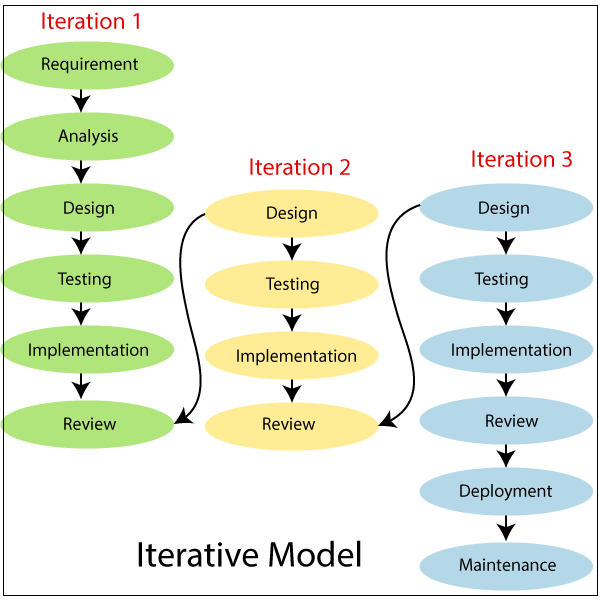
Summary
In general, each type of software development models will have its advantages and disadvantages. Depending on the project you are implementing, you can proceed to choose the right model type. These models of software engineering are all used by a large number of developers around the world. If they are exploited and deployed in the right direction, they will create good-quality software products at the lowest cost.
>> Our service: Custom Software Development











